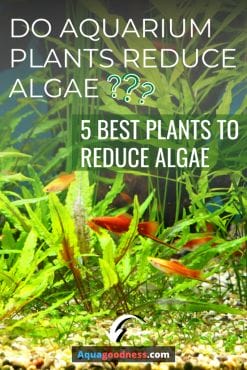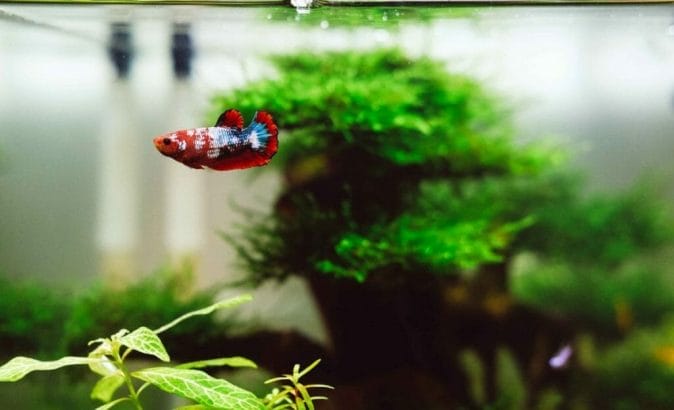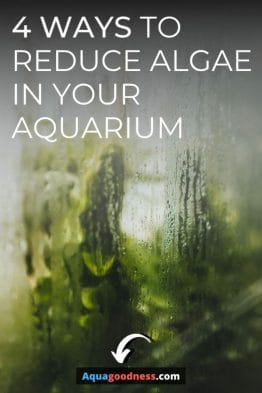If you are wondering, do aquarium plants reduce algae? then you are in the right place.
In this article, I am going to answer the same question.
I will also tell you how aquarium plants reduce algae. And the best aquarium plants you can keep in your tank to reduce algae.
So let’s dive in.

Table of Contents
So, do aquarium plants reduce algae?
Yes, live aquarium plants can help to reduce algae in your aquarium.
They do so by starving the algae for nutrients and light which restricts their growth.
How do aquarium plants reduce algae?

Live aquarium plants require light and nutrients for their growth.
And algae also require light and nutrients for their growth.
So, when you keep live aquarium plants in your aquarium then the plants will compete for nutrients and light with the algae.
So basically, the theory is the plants will absorb most of the nutrients and take advantage of the light. This will starve algae for nutrients and light which will restrict their growth.
However, if you keep the live plants in the tank are not able to absorb nutrients quickly then the algae will take advantage of the nutrients and the plants will suffer.
That’s why not all live aquarium plants are ideal to reduce algae in an aquarium.
Are Aquarium Plants Good? (Everything you need to know)
What are the best aquarium plants to reduce algae in an aquarium?
Basically, fast growing aquarium plants are good at reducing algae in an aquarium.
Fast growing aquarium plants require a lot of nutrients. So they will absorb the nutrients available in the aquarium pretty quickly to keep up with their fast growth.
This will starve algae for nutrients which will ultimately help to reduce algae in an aquarium.
Now I am going to mention some fast growing plants that are good to reduce algae in an aquarium.
1. Amazon Sword
See more images at Amazon here
| PARAMETERS | VALUES |
|---|---|
| PLANT | Amazon sword |
| SCIENTIFIC NAME | Echinodorus grisebachii |
| FAMILY | Alismataceae |
| CARE LEVEL | Easy |
| LIGHT REQUIREMENT | Moderate |
| GROWTH RATE | Fast |
| TEMPERATURE | 60.8-82.4°F |
| pH | 6.5-7.5 pH |
| HARDNESS | 8-15°dH |
| PLACEMENT | Background |
| MAXIMUM SIZE | 16 Inches |
| MINIMUM TANK SIZE | 10 Gallons |
Amazon sword is one of the most popular plants in the aquarium hobby.
This is a fast growing plant that can grow as tall as 16 inches.
This plant is very easy to care for which makes it an ideal choice for beginners.
Light requirements
Amazon sword does well under moderate lighting conditions.
So you should provide light anywhere between 2-3 Watts per gallon if you are using fluorescent light. Or 35 to 50 micromoles if you are using LED light.
And the light should be on for at least 11 to 12 hours every day.
Another thing to note is that you should not provide high lighting conditions. Or more light i.e. more than 12 hours every day to Amazon sword because it can lead to algae growth on the plant itself.
Best place to keep Amazon sword in the tank
Amazon sword is a tall-growing plant. So ideally, you should keep it in the background of your tank or in the center of your tank.
Substrate requirements
You can use any substrate of your choice to plant Amazon sword in your aquarium.
Just make sure that the substrate is at least 2.5 inches thick. Because Amazon sword is a root feeder aquarium plant. And it creates a complex root structure in the substrate so it requires space to create the structure.
Fertilization requirements
Amazon sword is a pretty hardy plant. And it can do well without any additional fertilizers.
However, to encourage faster growth, you should regularly supplement it with fertilizers.
You can supplement fertilizers in the form of liquid as well as root tabs.
Check the price of this plant at Amazon here
Do Aquarium Plants Absorb Ammonia?
2. Dwarf Sagittaria
See more images at Amazon here
| PARAMETERS | VALUES |
|---|---|
| PLANT | Dwarf Sagittaria |
| SCIENTIFIC NAME | Sagittaria subulata |
| FAMILY | Alismataceae |
| CARE LEVEL | Easy |
| LIGHT REQUIREMENT | Moderate |
| GROWTH RATE | Fast |
| TEMPERATURE | 68-82°F |
| pH | 6-8 |
| HARDNESS | 3-12 |
| PLACEMENT | Mid-foreground |
| MAXIMUM SIZE | 12 Inches |
| MINIMUM TANK SIZE | 10 gallon |
Dwarf Sagittaria is a fast growing aquarium plant. It is also one of the best flowering aquarium plants.
So it will quickly absorb all the nutrients from your aquarium which will starve algae for nutrients and restrict their growth.
Dwarf Sagittaria can tolerate a wide range of water parameters which makes it very easy to keep in your aquarium.
Light requirements
Dwarf Sagittaria is not very demanding when it comes to light.
It does well under moderate lighting conditions.
So you should provide it light between 2 to 3 Watts per gallon if you are using fluorescent light. Or light Between 35 to 50 micromoles if you are using LED.
Best place to keep Dwarf Sagittaria in your aquarium
Dwarf Sagittaria is a short plant and it is generally used as a carpet plant so you should keep it in the middle ground of the foreground of your aquarium.
Substrate requirements for Dwarf Sagittaria
Dwarf Sagittaria is a very hardy plant and you can keep it in any substrate.
However, if you keep it in a nutrient-rich substrate or soil substrate then it will grow faster.
Fertilization requirements
Dwarf Sagittaria is not very undemanding when it comes to fertilizers.
It can do well without any fertilizers.
However, if you provide it fertilizers then it will grow much faster.
Check the price of this plant at Amazon here
6 Tips to Take Care of Live Plants in Aquarium
3. Jungle Vallisneria
See more images at Amazon here
| PARAMETERS | VALUES |
|---|---|
| PLANT | Jungle Vallisneria |
| COMMON NAMES | Jungle Val, water celery, tape grass or eelgrass |
| SCIENTIFIC NAME | Vallisneria Americana |
| FAMILY | Hydrocharitaceae |
| CARE LEVEL | Intermediate |
| LIGHT REQUIREMENT | Medium |
| GROWTH RATE | Fast |
| TEMPERATURE | 65° – 85° F |
| pH | 6.8 – 8.0 |
| HARDNESS | Moderately Hard to Very Hard |
| PLACEMENT | Background |
| MAXIMUM SIZE | 6 feet (2 meters) |
| MINIMUM TANK SIZE | 10 gallon |
Jungle Vallisneria is a very popular plant in the aquarium hobby. It is also one of the best oxygenating plants.
This plant is very hardy and it can tolerate a wide range of water parameters which makes it an ideal choice for beginners.
It is a fast growing plant and it can grow as tall as 6 feet.
So, to keep up with the growth, it will require a lot of nutrients. And it will absorb all the nutrients from the aquarium which will starve the algae for nutrients. And restrict its growth.
Light requirements
Jungle Vallisneria is not very demanding when it comes to light.
You can keep it under low as well as high lighting conditions.
However, under higher lighting conditions it will grow much faster.
Best place to keep Jungle Vallisneria in your tank
As mentioned earlier, Jungle Vallisneria can grow as tall as 6 feet. So ideally, you should keep it in the background of your tank.
Substrate requirements
Jungle Vallisneria is a pretty hardy plant. And it can do well without any additional fertilizers.
However, for fast and robust growth, you should regularly supplement it with fertilizer, especially iron-rich fertilizers.
Check the price of this plant at Amazon here
8 Best Aquarium Plants for Sand Substrate
4. Java Moss
See more images at Amazon here
| PARAMETERS | VALUES |
|---|---|
| PLANT | Java moss |
| SCIENTIFIC NAME | Vesicularia dubyana |
| FAMILY | Hypnaceae |
| CARE LEVEL | Very easy |
| LIGHT REQUIREMENT | Low to Bright |
| GROWTH RATE | Fast |
| TEMPERATURE | 59-86°F |
| pH | 5.0 to 8.0 |
| HARDNESS | 60- 240 ppm |
| PLACEMENT | Foreground |
| MAXIMUM SIZE | 4 inches |
| MINIMUM TANK SIZE | 5 gallon |
Java moss is one of the most popular aquarium plants in the hobby.
This is a fast growing aquarium plant. And it is usually used as a carpet plant.
Java moss can tolerate a wide range of water parameters. And you can easily keep it in cold water as well as tropical aquarium.
It will quickly absorb the nutrients from your aquarium which will starve algae for the nutrients and restrict their growth.
There are also other benefits of keeping Java moss such as it is a very good plant to keep in a breeding tank because it will provide protection to the eggs and fry.
Besides, Java moss is very popular among aquascapers because it can be used to create beautiful results.
Light requirements
Java moss is a pretty hardy plant and it doesn’t have any particular light requirements.
It will grow in low as well as high lighting environment.
However, under high lighting environment, it will grow faster.
Best place to keep Java moss in your aquarium
One of the reasons Java moss is very popular among aquascaper is that there are several locations and several ways you can keep it in your aquarium.
You can tie it to any ornament in your aquarium like driftwood or rock.
You can also use it as a carpet plant and keep it in the middle ground and foreground of your aquarium.
Or you can literally toss it in your aquarium and it will find its place and get attached to something in your tank.
Substrate requirements
Java moss doesn’t have any roots so you don’t need any particular substrate for keeping Java moss in your aquarium.
Fertilization requirements
Java moss is a pretty hardy plant and it can do well without any additional fertilizers.
However, if you want to encourage faster, denser, and compact growth then you should regularly supplement it with liquid fertilizers.
Check the price of this plant at Amazon here
Are Aquarium Plant Fertilizers Safe For Fish? (Best fish safe fertilizers)
5. Water lettuce
See more images at Amazon here
| PARAMETERS | VALUES |
|---|---|
| PLANT | Water Lettuce |
| SCIENTIFIC NAME | Pistia |
| FAMILY | Araceae |
| CARE LEVEL | Moderate |
| LIGHT REQUIREMENT | Moderate |
| GROWTH RATE | Moderate |
| TEMPERATURE | 70 to 80 °F |
| pH | 6.5-7.2 pH |
| HARDNESS | Soft to Moderately Hard |
| PLACEMENT | Water Surface |
| MAXIMUM SIZE | 10 inches |
| MINIMUM TANK SIZE | 10 gallon |
Water lettuce is a fast growing floating aquarium plant.
It will absorb a lot of nutrients from your tank for its growth which will starve algae for nutrients in your aquarium.
This plant is a bit tricky to keep in an aquarium because it requires humid conditions.
However, if you provide it the ideal conditions then it will quickly overtake your tank.
Light requirements
You should provide medium lighting conditions to water lettuce.
For fluorescent light, you should provide 2 to 3 Watts per gallon.
And if you are using LED then you should provide light anywhere between 35 to 50 micromoles.
Best place to keep Water lettuce in your aquarium
Water lettuce is a floating aquarium plant. So you should keep it floating on the surface of the water of your aquarium.
Substrate requirements
As water lettuce is a floating aquarium plant, it doesn’t require any substrate to keep in your aquarium.
Fertilization requirements
Water lettuce doesn’t require any additional fertilizers. It will absorb nutrients from your aquarium for its growth.
Check the price of this plant at Amazon here
13 Best Aquarium Plants For Gravel Substrate
Ways to reduce algae in your aquarium

Besides, keeping aquarium plants in your tank there are several other ways you can reduce algae in your aquarium.
1. Control lighting
One of the most common reasons for algae growth in an aquarium is uncontrolled lighting.
First of all, you are aquarium should not be directly exposed to the sunlight.
Because this can cause algae growth in your aquarium.
If you are using artificial light like LED light or fluorescent line light then make sure that you are not keeping the lights on for more than 10 hours and the lighting is consistent.
I know that it can be very hard to provide consistent lighting manually to the plants.
So the solution is to use a timer. It will turn on or off the light at a specific time.
This way the plants will get consistent light and it will help to control algae growth in your aquarium.
Do Aquarium Plants Need CO2? (Can you keep them without co2)
2. Control feeding
Overfeeding the fish is another common cause of algae growth in an aquarium.
Fish seems like they are always hungry and most beginners make the mistake of overfeeding their fish.
The problem is, fish food contains phosphate and when you overfeed your fish, the leftover fish food will increase the phosphate level in your aquarium which can cause brown diatom algae.
So, to avoid overfeeding, you should feed a little bit of food to your fish and then wait for 5 minutes.
If the fish has not eaten all the food then you are overfeeding your fish.
So, in this case, you should cut back on food and also remove the uneaten food from the tank.
11 Best Red Aquarium Plants (Beginner Friendly and Undemanding)
3. Test your water
While doing a water change, first of all, you should test the water that you are going to add to your aquarium.
This is important because algae grow in an aquarium when there is an excess phosphate level in the aquarium.
And if the water you’re adding in your aquarium has high phosphate levels then it will cause algae growth in your aquarium.
The ideal phosphate level for freshwater aquarium is 0.5 ppm.
So first of all, you should test the water you are going to add to your aquarium with a test kit.
API sells phosphate test kit. You can check it out at Amazon here.
If the water has a high phosphate level then you can either use a phosphate removing chemical.
Or you can insert a phosphate removing media into the filter of your aquarium which will remove phosphate from your aquarium.
Seachem sells phosphate removing media under PhosGuard name. You can check its price at Amazon here.
While adding the media, don’t forget to use a media bag.
Or you can use other water sources like filtered water for the water change.
Are Aquarium Plants Hard To Keep? (And how to keep them healthy)
4. Keep algae eating crew
You can keep algae eating fish like Bristlenose pleco, Siamese algae eater, Chinese algae eater, etc.
If you have a smaller tank then you can keep small species of catfish like cory catfish in your tank.
They will eat algae in your tank which will help to reduce algae in your aquarium.
20 Tips to Maintain a Healthy Aquarium
FAQ

In case your aquarium plant has a very small amount of algae on its leaves then you can simply brush or gently rub the plant in the aquarium to remove algae.
In case your aquarium plant has a lot of algae growth on its leaves then you take out the plants from the substrate. And rub it with your hands and then put it back inside your aquarium.
In the case of extreme algae growth, you can soak the plants in a mild bleach solution to remove algae.
There are 6 types of algae grow on fish tanks-
1. Brown diatom algae
2. Black beard algae
3. Hair algae
4. Green spot algae
5. Blue-green algae
6. Green water
12 Benefits of Live Plants in an Aquarium (Pros and Cons)
Conclusion
In a nutshell, live aquarium plants do help to reduce algae in your aquarium.
You just have to make sure that the live plants you are keeping in your tank are fast growing.
So that the plants will absorb nutrients from your tank quickly which will starve the algae in your tank for nutrients that will ultimately help to reduce algae in your aquarium.




